8. Textures of Liquid Crystals
The cholesteric LCs can be considered as the twisted nematics. The twist can vary in wide range. The cholesteric mixture can be prepared by mixing the nematic LC and a chiral dopant. The needed concentration C of the chiral dopant is given by
C = (p HTP)-1,
where HTP is helical twisting power of the chiral dopant and p is the necessary pitch.
On the other hand, the cholesterics with the
pitch much smaller than the size of deformations can be
considered to have a quasi-layered structure, similar to the smectic phase.
The complex structure of the cholesterics leads to much more complicated
defects and textures than in the nematics.
Textures of Isotropic - Cholesteric Phase Transition
The isotropic – cholesteric phase transition is of the first order, i.e., the cholesteric phase appears through nucleation and often two coexisting phases are observed (Fig.26).
(a) |
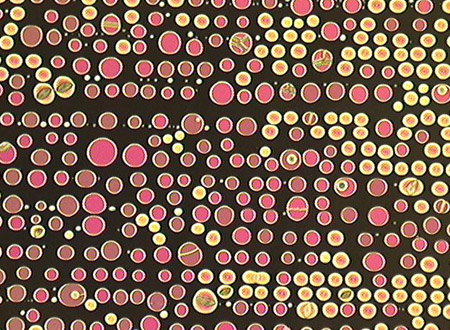
|
(b) |
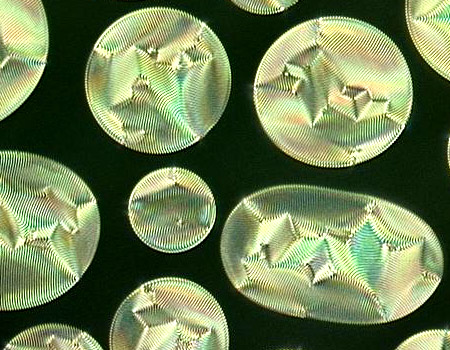
|
(c) |
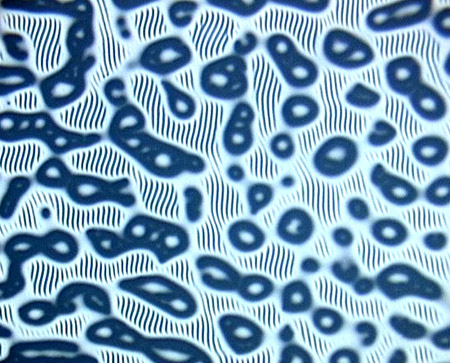
|
|
Figure 26. Textures of isotropic - cholesteric phase transition: black areas correspond to isotropic phase | |
Often nuclei for the cholesteric phase are located at the irregularities created by rubbing, and, domains of the cholesteric phase are arranged along the rubbing direction (Fig.26a).
The blue phase exists in some cholesteric materials with very small pitch, p<1μm. Usually the blue phase exists within a narrow temperature range, about several degrees, between the cholesteric and isotropic phases. Recently, the cholesteric material with a wide temperature range of existence, about 50-80o, was synthesized. Under the microscope, the blue phases in reflected light appear as a platelets texture (Fig.27).
(a) |
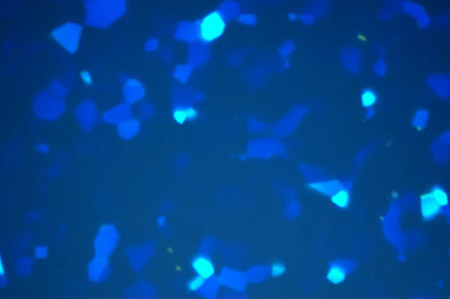
|
(b) |
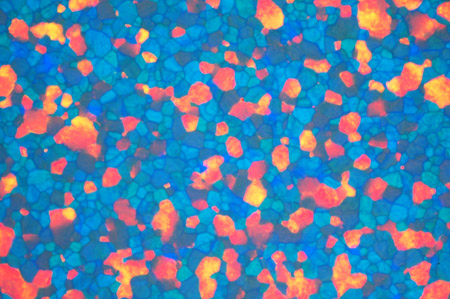
|
|
Figure 27. Textures of "blue phase" in cholesterics: temperature decreases from (a) to (b) | |
The blue phases can be interesting for the three-dimensional band gap photonic applications due to their tree-dimensional periodic structure.
Textures of Planar Cholesteric Structures
In the case when the cholesteric liquid crystal is confined between two substrates with planar anchoring, the director n is oriented parallel to the substrates but the helical axis is normal to the substrates (Fig.28).
|
Figure 28. Cholesteric liquid crystal structures |
The homogeneous planar cholesteric structure shows uniform texture with color depending on the pitch and/or phase retardation. On the contrary, different types of irregularities in the cholesteric LC cell can provoke the appearance of defects called oily streaks (Fig.29).
(a) |
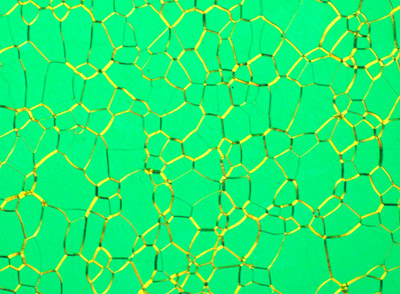
|
(b) |
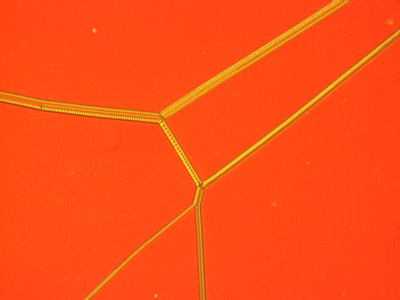
|
|
Figure 29. Oily streaks in planar cholesteric liquid crystal cell | |
The cholesteric quasi-layers are strongly curved inside the oily streaks.
The wedge design of the LC cell allows for observations of dislocation lines (Fig.30) due to the periodic structure of the cholesterics.
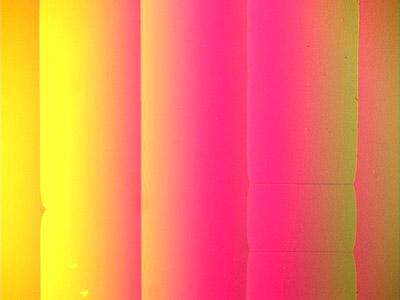
|
|
Figure 30. Texture of cholesteric liquid crystal in wedge cell |
Also, the wedge cell is usually used for the cholesteric pitch measurements.
Electric Field-Induced Textures of Planar Cholesteric Structures
Another interesting texture can be observed when applying the weak electric field normal to the cholesteric planar quasi-layers. The dielectric torque tends to reorient the layers along the electric field but free rotation is hindered by limiting surfaces. As a result the layers undergo some periodic sinusoidal deformations called undulations (Figs.31,32). The similar effect shows in smectics under the mechanical dilation when the smectic layers rotate increasing the effective layers thickness in order to fill the additional space created by dilation. The undulations texture strongly depends on the ratio d/p (thickness/pitch). When the ratio is small, d/p≤3, the cholesterics layers undulate only in one direction (Fig.31).
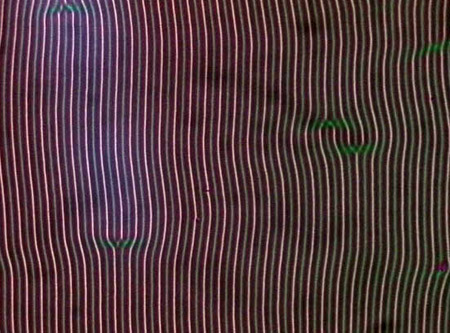
|
|
Figure 31. One-dimensional undulations in cholesteric liquid crystal, d/p≤3 |
One observes the texture where the layers periodically undulate in two directions creating the square lattice of deformations (Fig.32) when d/p>10.
(a) |
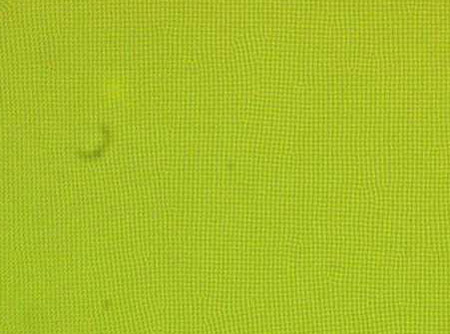
|
(b) |
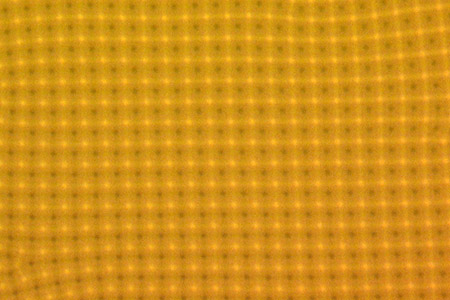
|
|
Figure 32. Two-dimensional undulations in cholesteric liquid crystal with different pitch, d/p>10: pitch increases from (a) to (b) | |
The FCPM textures of the undulations in the cholesterics (Fig.33) show that, indeed, the square lattice of the distortions observed with polarizing microscope (Fig.32) corresponds to the periodical sinusoidal buckling of the cholesteric quasi-layers.
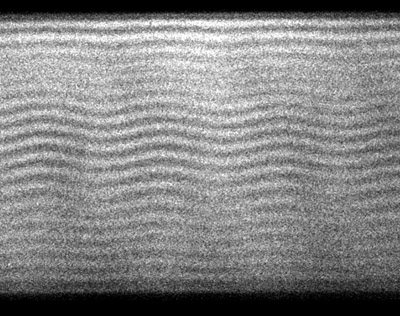
|
|
Figure 33. FCPM texture of cross-section view of undulations in cholesterics: distance between two neighboring bright stripes corresponds to layers thickness p/2 |
The undulations periodicity depends on cell thickness and cholesteric
pitch, Lu∝(p d)1/2.
The two-dimensional undulations in cholesteric liquid crystals
can be used for laser beam steering (Fig.34).

|
|
Figure 34. Diffraction pattern produced by undulations in cholesteric liquid crystal |
Textures of Cholesterics between Homeotropic Boundaries
In the cholesteric structures between homeotropic boundaries the director is oriented perpendicular to substrates and the helical axis is in the plane of the LC cell (Fig.28). The appearance of such textures depend on the ratio thickness/pitch (Fig.35).
(a) |
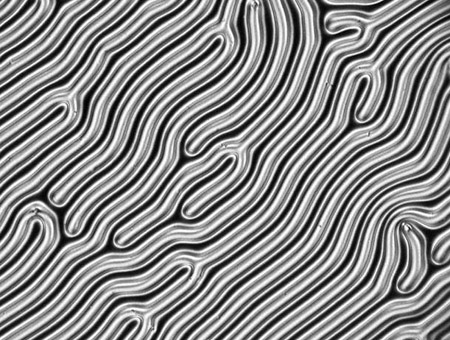
|
(b) |
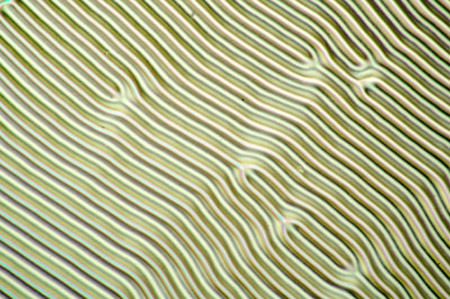
|
(c) |
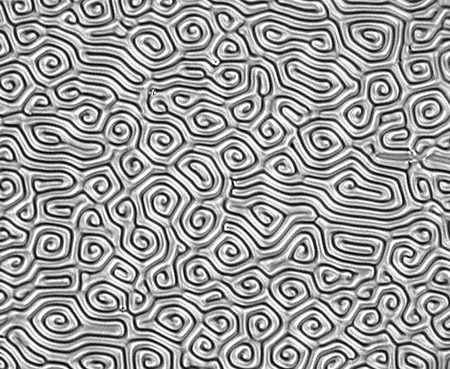
|
|
Figure 35. Fingerprint texture in cholesteric liquid crystals with different d/p; d/p increases from (a) to (c) but is less than 3 | |
These textures are called “fingerprint” textures due to their specific appearance. Strong homeotropic anchoring can untwist a cholesteric in thin cells.
Polygonal Cholesteric Textures
The polygonal textures can be observed in cholesteric liquid crystals when the cholesteric quasi-layers have oblique orientation with respect to the substrates, i.e., the helical axis is strongly tilted with respect to the substrates.
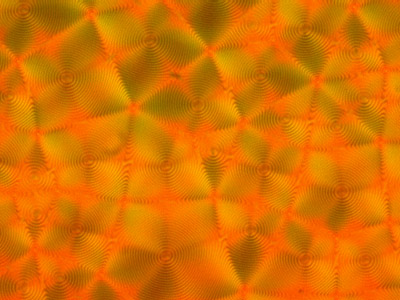
|
|
Figure 36. Polygonal texture in cholesteric liquid crystal |
Prev
Textures of nematics
Next
Textures of smectics